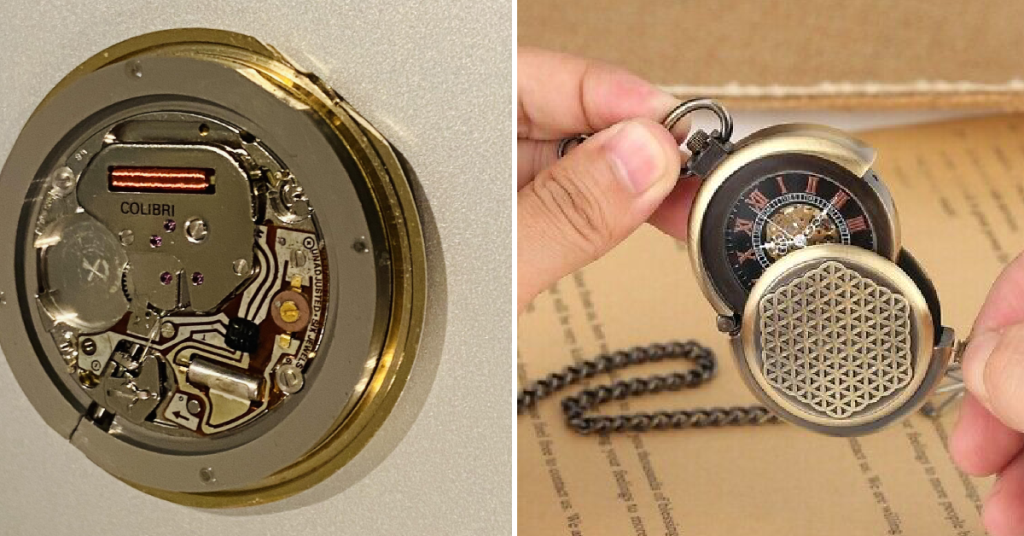Welcome, watch enthusiasts and vintage fashion lovers! If you’re reading this, chances are you’ve got a pocket watch that’s as stylish as it is sentimental. Pocket watches are not just timepieces; they are pieces of history and style statements rolled into one. But like all great things, they need a bit of TLC to keep ticking.

In this guide, we’ll walk you through the ins and outs of changing a pocket watch battery. Whether you’re a seasoned collector or just starting out, these step-by-step instructions will equip you with everything you need to keep your beloved watch in top form.
The Components of a Pocket Watch
Before we get into the nitty-gritty of battery replacement, let’s familiarize ourselves with the components of a pocket watch. Understanding these parts will make the whole process much simpler. The watch case is the outer shell that protects the intricate mechanisms inside and is often made from sturdy materials like stainless steel, gold, or silver. This part is essential for both function and fashion. The crystal is the transparent cover that shields the watch face, typically made from glass, acrylic, or sapphire, and not only protects the dial but also adds to the watch’s aesthetic appeal. The movement is the heart of the watch, where all the mechanical magic happens, containing tiny gears, springs, and, of course, the battery that powers it all. Understanding the movement is key to successful battery replacement.
Signs It’s Time to Change the Battery
Knowing when to change your pocket watch battery is crucial for its longevity. Here are some telltale signs that it’s time for a battery swap.
Time Loss or Gain: One of the most obvious signs is that your watch starts losing or gaining time erratically. If you notice that your watch is consistently off, it’s likely time for a new battery.
The Second Hand Jumps: Another common indicator is a jumping second hand. Instead of a smooth motion, the second hand may start to jump several seconds at a time. This is usually a clear sign that your battery is running low.
Complete Stop: Lastly, if your watch completely stops, it’s a definite sign that the battery is dead. While this might seem obvious, some people overlook this straightforward symptom.
Tools and Materials Needed for the Job
Changing a pocket watch battery isn’t a Herculean task, but it does require some specialized tools and materials. Here’s what you’ll need.
A Watch Case Opener: A watch case opener is designed to safely pry open the case without damaging it. This tool is essential for accessing the battery compartment.
Tweezers: Tweezers will help you handle small components without losing them. Opt for non-magnetic tweezers to avoid affecting the watch’s delicate parts.
A New Battery: Make sure you have the correct battery for your watch. Consult the watch’s manual or take the old battery with you to the store to find an exact match.
Step-by-Step Guide to Changing a Pocket Watch Battery
Now that we’ve covered the basics, let’s get into the step-by-step process of changing your pocket watch battery.
Step 1: Open the Watch Case
First, use your watch case opener to carefully pry open the back of the watch case. Be gentle to avoid scratching or damaging the case. Place the back cover in a safe spot where it won’t get lost.
If the watch back is screwed on, use a case opener that fits the grooves properly to unscrew it. For press-fit backs, apply gentle pressure with a knife-style opener at the lip of the case edge. Take your time to prevent any accidental slips or damage. Once open, inspect the seal and note any dust or dirt that might have accumulated, as this is a good opportunity to clean the case. Secure the back cover in a safe place to ensure it doesn’t get misplaced.
Step 2: Remove the Old Battery
Next, use your tweezers to carefully remove the old battery. Gently grip the battery and lift it out of its slot, ensuring you don’t damage any surrounding components. Take note of the battery’s orientation so you can insert the new one correctly. If needed, take a quick photo for reference. Dispose of the old battery responsibly by following local regulations for electronic waste. Remember, proper disposal helps protect the environment.
Step 3: Insert the New Battery
With your tweezers, place the new battery into the battery compartment. Ensure it’s seated correctly and securely. Double-check the orientation to make sure the positive and negative sides are aligned. Once properly positioned, gently press the battery into place to ensure firm contact with the terminals. If needed, use a small amount of pressure to secure it. After insertion, take a moment to inspect the surrounding area for any debris or obstructions that may affect the battery’s performance. Finally, ensure that the battery compartment cover is ready to be replaced, checking that all screws or closures are available to secure it tightly.
Step 4: Close the Watch Case
Finally, snap the back cover of the watch case back into place. Make sure it’s secure to prevent dust and moisture from entering the watch. Once the cover is aligned correctly, press it firmly until you hear a click, indicating it is properly sealed. It is a good idea to check the edges to ensure that there are no gaps. This will help maintain the watch’s water resistance and protect the delicate internal components. If you notice any resistance or difficulty in closing, double-check the alignment and try again. After closing the case, gently shake the watch to confirm that the cover is tightly in place.
Testing the Watch
Once you’ve replaced the battery, it’s time to test your pocket watch to make sure everything is functioning correctly.
Check the Time Accuracy: Set the watch to the correct time and monitor it for a few hours to ensure it’s keeping time accurately. If it’s still losing or gaining time, you may need to readjust the battery or consult a professional.
Inspect the Second Hand: Observe the second hand for any irregular movements. A smoothly moving second hand indicates that the new battery is working perfectly.
Listen for Ticking: Hold the watch close to your ear and listen for the ticking sound. A consistent tick-tock means your watch is back in business.
Tips for Maintaining and Preserving Your Pocket Watch
Now that your pocket watch is ticking away happily, let’s discuss some tips for keeping it in pristine condition.
Regular Cleaning: Regularly clean your pocket watch to remove dust and grime. Use a soft cloth and avoid harsh chemicals that could damage the watch’s finish.
Avoid Magnetic Fields: Keep your pocket watch away from strong magnetic fields, as they can interfere with its movement. This includes household items like speakers and electronic devices.
Store Properly: When not in use, store your pocket watch in a protective case. This will shield it from dust, moisture, and accidental drops.
FAQs about Changing a Pocket Watch Battery
How often should I change the battery in my pocket watch?
The recommended frequency for battery replacement varies depending on the type of watch and its usage. As a general rule, it’s best to replace the battery every 1-2 years or when you notice any symptoms of a dying battery, such as the watch losing time or stopping altogether. Regular maintenance can also help prevent potential issues down the line.
Can I change the battery in my pocket watch myself?
Yes, you can change the battery yourself as long as you have the necessary tools and follow proper instructions. It’s important to handle the watch and its components with care to avoid damage. However, if you’re not comfortable with the process, it’s always best to seek professional help. A professional can ensure the battery is replaced correctly and check for any other maintenance needs your watch might require.
What tools do I need to change a pocket watch battery?
To change the battery, you’ll typically need a small screwdriver to open the case, a pair of tweezers to handle the battery, and potentially a case opener if your watch design requires it. Ensure you have a clean, well-lit workspace to prevent losing small parts.
Are there any precautions I should take when changing the battery?
Yes, take care to touch the battery and watch components as little as possible to avoid transferring oils and dirt from your fingers. It’s also advisable to work on a soft surface to prevent scratches or damage if the watch is accidentally dropped.
Conclusion
Maintaining a pocket watch isn’t just about keeping time; it’s about preserving a piece of history and a statement of style. With a little care and attention, your pocket watch can continue to be a cherished accessory for years to come.
If you found this guide helpful and want more tips on maintaining your timepieces, consider subscribing to our newsletter or booking a consultation with one of our watch experts. Let’s keep those timeless pieces ticking!






